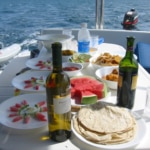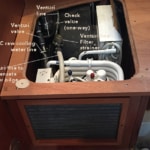Sailing Vector Game
Learn Sailboat Giveway Rules and Cure Boredom at the Same Time.
Here is a fun sailing game you can play ol’ school like when stuck on an airplane with a sailing buddy. It’s kinda like the old Race Car Vector Grid game but better ’cause it’s sailing. If you can drag your kids off the iPad, give it a go with them as well.
If you like this game LIKE it over there —>
Sailing Vector Game
Here is an example of a basic course layout.
Sailing Vector Game grid example course
And here is a blank sheet to create your own courses
Sailing Vector Game grid blank
Take a piece of Math Grid Paper. At the bottom left draw a horizontal start line approx. 6 squares across.
Draw the wind direction directly down the page. Lay out a course. For example, first buoy to windward, then second buoy across the page to the right, then 3rd buoy to leeward close to the bottom right of the page then back to first buoy then back through the start finish gate. Label the buoys Port or Starboard meaning the side of the boat all boats must leave the buoy to when rounding. Draw in some menacing islands.
Here is an example of a game played which takes about 20 minutes.

A game played
Playing the Game
Read the rules through a few times. You’ll start to get it after a while. Pay particular attention to allowable maneuvers and giveway rules.
Maneuvering
- Boats move by vectors in the grid denoted as Upwind and Downwind and or across wind on Starboard or across wind on Port.
- Upwind is listed as U, downwind is listed as D. Across wind is listed as S(starboard) or P (port). E.g 1U:2S means the boat moves 1 square towards the wind and 2 squares to the left (boat on starboard)
- Boats can only maneuver by increasing or decreasing the previous vector by maximum of 1 in only 1 of the Upwind/Downwind or Port/Starboard directions. However, if both vectors equal then the boat can accelerate or decelerate by 1 up AND by 1 cross.
- At anytime the minimum move will be at least 1 square.
- Loose two turns for repairs if you hit an island or go off the board.
Upwind and Tacking Maneuvers
- Boats can not move more than 45 deg into the wind i.e. the Up vector number can not be more than the cross wind vector number.
- A boat can tack through the wind at anytime. When the boat tacks the next starting vector is 1U:1(S or P)
Upwind and tacking examples:
1U:1S can accelerate to 2U:2S then to 3U:3S then to 4U:4S
2U:2S can decelerate to 1U:1S
2U:2S can turn to 1U:2S or 2U:3S
3U:3S can tack to 1U:1P
1U:1S tacks to 1U:1P
0U:3S tacks to 1U:1P
5D:3P tacks to 1U:1S
2U:1S is invalid because it is too close to the wind i.e upwind vector is greater than crosswind vector
Downwind and gybing maneuvers
- A boat can go in any downwind direction, but the down vector can not be more than 3 greater than the cross vector because of reduced apparent wind. i.e. 3D:0S, 4D:1P, 5D:2P are valid whereas 4D:0S, 5D:1S are not valid
- A boat can gybe between S and P but each time it will loose speed by 1 in each direction. i.e. 3D:3S gybe goes to 2D:2P on the opposite tack setting. If the crosswind vector is 1, then it remains at 1 on the other gybe setting. e.g. 3D:1S gybe results in 2D1P
- When going directly downwind i.e. 0(S orP) a gybe reduces the downwind by 1 but the 0 across remains 0. Thus, a gybe from 3D:0S will go to 2D:0P
- When on a beam reach e.g. 0D:3P a gybe causes the boat to decelerate 1 in the cross direction but angles downwind by 1. e.g. 0D:3P gybes to 1D:2S
- 1D:1S gybes to 1D:1P and vice versa
Downwind and gybing examples:
4D:1S gybe goes to 3D:1P
5D:2S gybe goes to 4D:1P
3D:0S gybe goes to 2D:0P
4D:1S can slow to 3D:1S
4D:1S can not accelerate to 5D:1S
0D:3S gybe goes to 1D:2S
3U:3S gybe goes to 2D:2P
1U:1S gybe goes to 1D:1P
Starting
- Players start anywhere they select but 1 square downwind from the start line
- Players can not be on or pass the start line until after their 4th turn
- A Players first move is either 1S or 1P
- No violation of the giveway rules prior to start
Giveway Rules:
- A boat on Port can not come close abeam or forward of another boat’s position on starboard at anytime during its maneuver. Close is defined by all positions 1(U or D)1:1(S or P) relative to the starboard boat’s position that are abeam or forward.
- When on the same tack, a windward boat can not land on any possible position of the leeward’s boat next landing position.
- A Port boat can not land on any possible position of a starboard’s boat next landing position.
- No boat can make a maneuver to force another boat to leave the page.
- No boat may land on another boat’s current position.
Have Fun!





